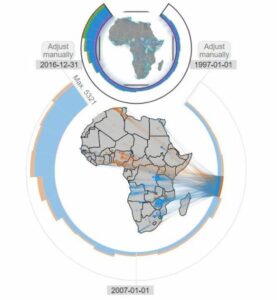| Georgii Kostiuchik, Lalith Sharan, Benedikt Mayer, Ivo Wolf, Bernhard Preim, Sandy Engelhardt Surgical Phase and Instrument Recognition: How to identify appropriate Dataset Splits Journal Article International Journal of Computer Assisted Radiology and Surgery, pp. 21, 2023. BibTeX | Links: @article{Kostiuchik_JCARS_2023,
title = {Surgical Phase and Instrument Recognition: How to identify appropriate Dataset Splits},
author = {Georgii Kostiuchik and Lalith Sharan and Benedikt Mayer and Ivo Wolf and Bernhard Preim and Sandy Engelhardt},
doi = {https://doi.org/10.48550/arXiv.2306.16879},
year = {2023},
date = {2023-10-31},
journal = {International Journal of Computer Assisted Radiology and Surgery},
pages = {21},
keywords = {},
pubstate = {published},
tppubtype = {article}
}
|
 | Benedikt Mayer, Nastasja Steinhauer, Bernhard Preim, Monique Meuschke A Characterization of Interactive Visual Data Stories With a Spatio-Temporal Context Journal Article Computer Graphics Forum, n/a (n/a), pp. e14922, 2023. BibTeX | Links: @article{https://doi.org/10.1111/cgf.14922,
title = {A Characterization of Interactive Visual Data Stories With a Spatio-Temporal Context},
author = {Benedikt Mayer and Nastasja Steinhauer and Bernhard Preim and Monique Meuschke},
url = {https://onlinelibrary.wiley.com/doi/abs/10.1111/cgf.14922},
doi = {https://doi.org/10.1111/cgf.14922},
year = {2023},
date = {2023-08-18},
journal = {Computer Graphics Forum},
volume = {n/a},
number = {n/a},
pages = {e14922},
keywords = {},
pubstate = {published},
tppubtype = {article}
}
|
| Benedikt Mayer, Monique Meuschke, Jian Chen, Beat Müller-Stich, Martin Wagner, Bernhard Preim, Sandy Engelhardt Interactive Visual Exploration of Surgical Process Data Journal Article International Journal of Computer-Assisted Radiology and Surgery, 18 (1), pp. 127-137, 2023. BibTeX | Links: @article{Mayer_2023_IJCARS,
title = {Interactive Visual Exploration of Surgical Process Data},
author = {Benedikt Mayer and Monique Meuschke and Jian Chen and Beat Müller-Stich and Martin Wagner and Bernhard Preim and Sandy Engelhardt},
url = {https://link.springer.com/article/10.1007/s11548-022-02758-1},
year = {2023},
date = {2023-01-17},
journal = {International Journal of Computer-Assisted Radiology and Surgery},
volume = {18},
number = {1},
pages = {127-137},
keywords = {},
pubstate = {published},
tppubtype = {article}
}
|
 | Benedikt Mayer, Kai Lawonn, Karsten Donnay, Bernhard Preim, Monique Meuschke VEHICLE: Validation and Exploration of the Hierarchical Integration of Conflict Event Data Journal Article Computer Graphics Forum, 40 (3), 2021. BibTeX | Links: @article{mayer_2021_eurovis,
title = {VEHICLE: Validation and Exploration of the Hierarchical Integration of Conflict Event Data},
author = {Benedikt Mayer and Kai Lawonn and Karsten Donnay and Bernhard Preim and Monique Meuschke},
url = {https://diglib.eg.org/bitstream/handle/10.1111/cgf14284/v40i3pp001-012.pdf, PDF Download},
year = {2021},
date = {2021-01-01},
journal = {Computer Graphics Forum},
volume = {40},
number = {3},
keywords = {},
pubstate = {published},
tppubtype = {article}
}
|
| Benedikt Mayer Visual Analytics of Participant Evolution in Longitudinal Cohort Study Data Miscellaneous 2018, (Individualprojekt). BibTeX | Links: @misc{Mayer_IP_2018,
title = {Visual Analytics of Participant Evolution in Longitudinal Cohort Study Data},
author = {Benedikt Mayer},
url = {https://www.vismd.de/wp-content/uploads/legacy/mayer_ip_2018.pdf, PDF Download},
year = {2018},
date = {2018-01-01},
note = {Individualprojekt},
keywords = {},
pubstate = {published},
tppubtype = {misc}
}
|


